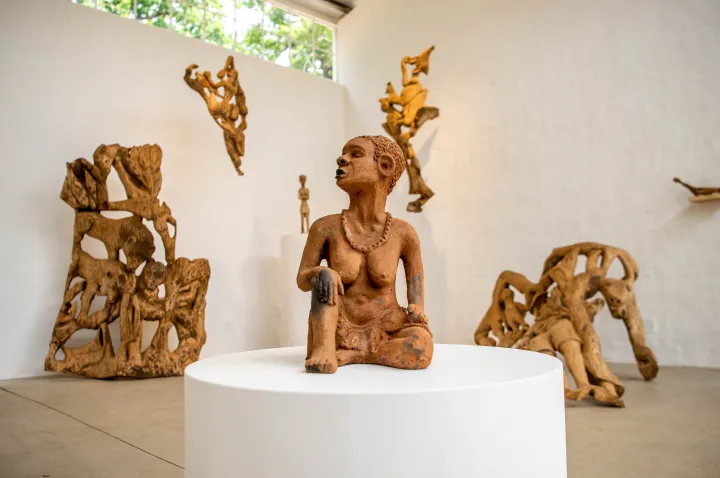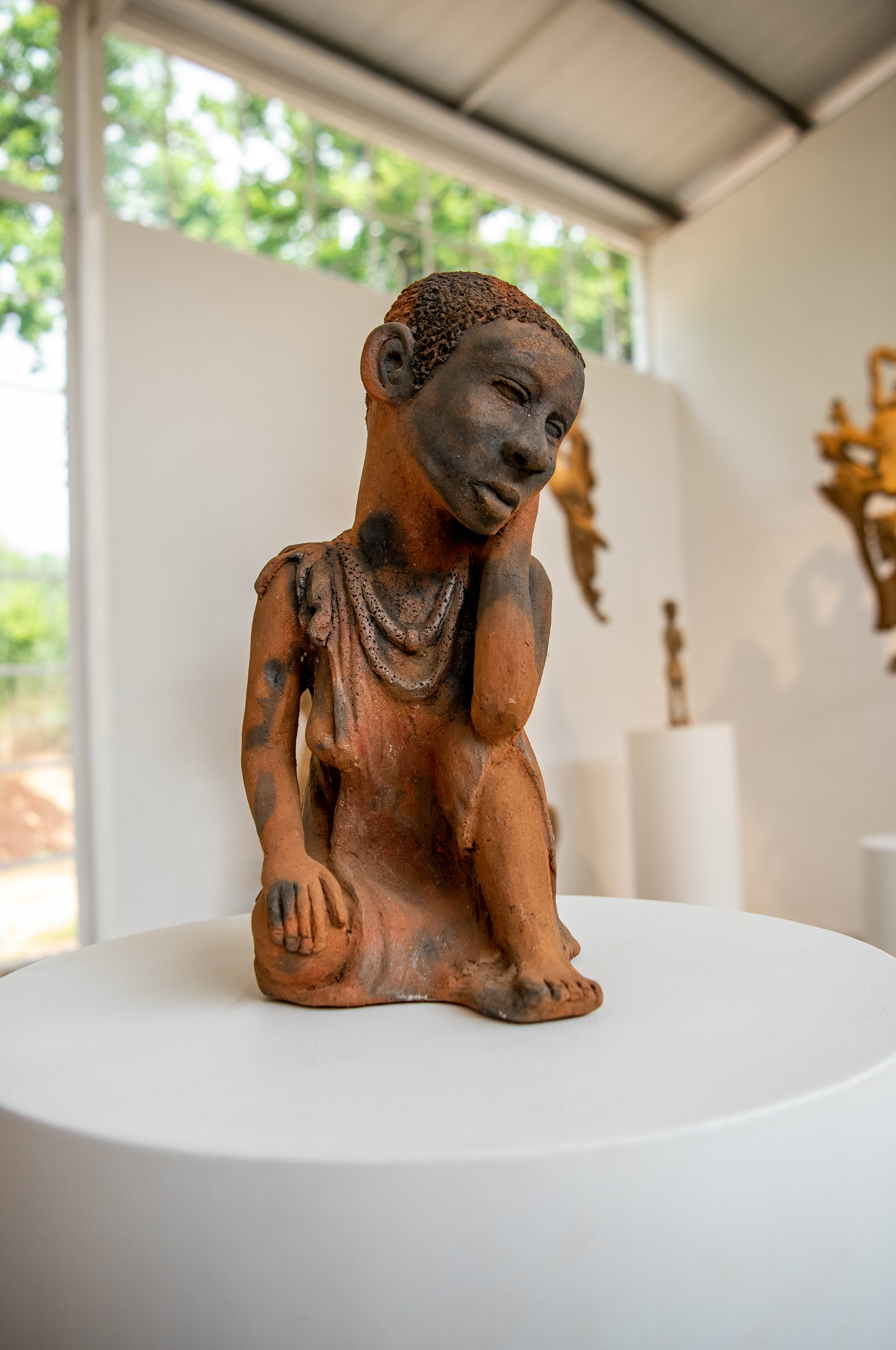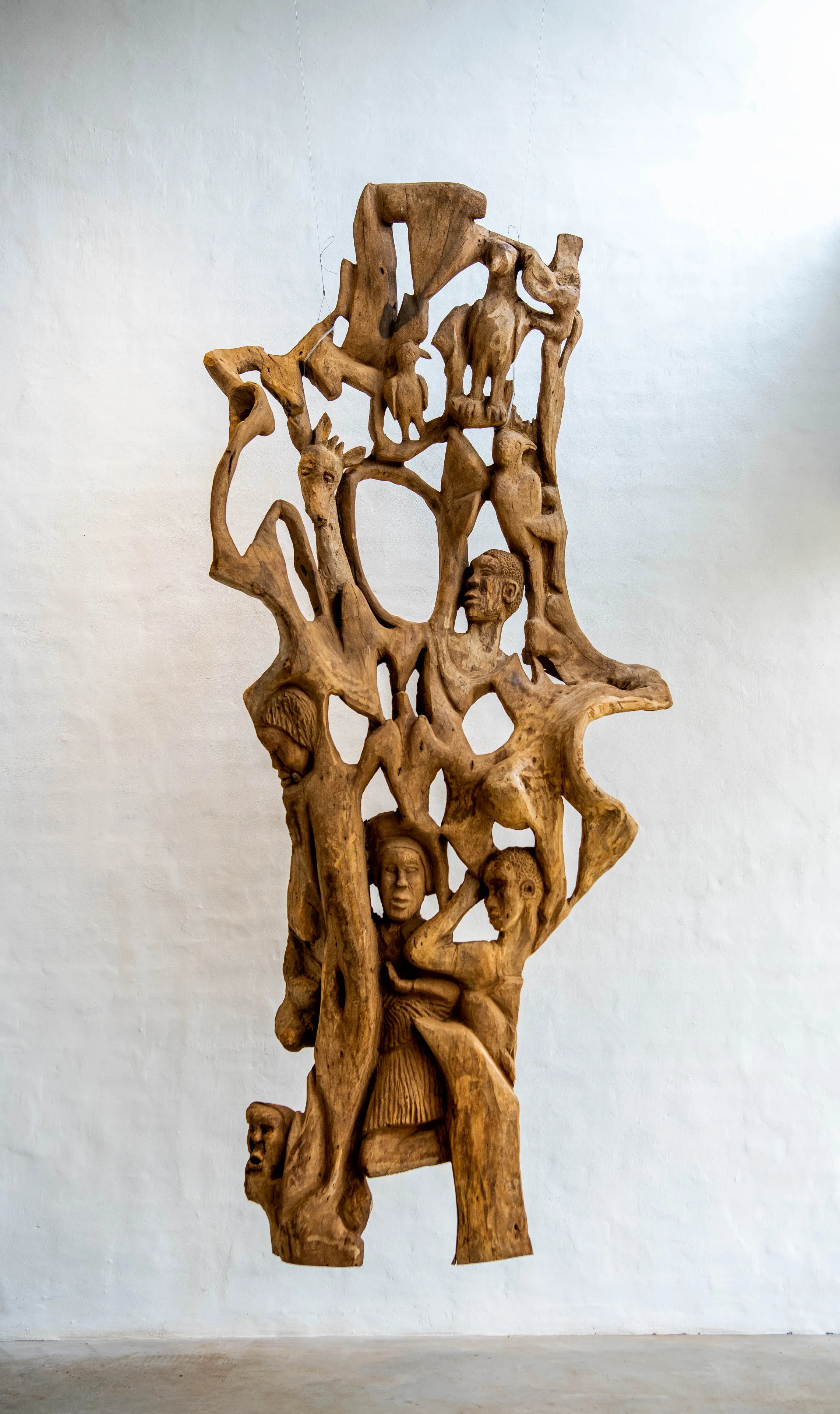ART OP-ED
On the instinctual strength of Noria Mabasa’s art

Noria Mabasa’s latest exhibition, Shaping Dreams, at the recently opened Villa-Legodi Centre for Sculpture at Nirox Sculpture Park captures the wager between the conscious and unconscious and much more.
Noria Mabasa understands creation, making art with clay and wood, as the outcome of dreaming. As such, her work is informed by a realm that is profoundly unintelligible, unless, like Sigmund Freud or Jacques Lacan, one believes that dreams, the unconscious, possess a structure. As Freud problematically pronounced, “The interpretation of dreams is the royal road to a knowledge of the unconscious activities of the mind.” I am sceptical. The desire for structure, intelligible form, reason, is neither ‘royal’ nor inherently well-founded.
The current collapse of reason, the enlightenment and its democratic scaffolding, is a reminder that one cannot structure the unconscious. That said, it is also unsurprising that we should seek to reassert this folly. As novelist Pankaj Mishra notes, “Well-worn pairs of rhetorical opposites, often corresponding to the bitter divisions in our societies, have once again been put to work: progressive vs reactionary, open vs closed, liberalism vs fascism, rational vs irrational.” However, Mishra resumes, “as a polarised intellectual history plays catch-up with fast-moving events that it failed to anticipate, it is hard to avoid the suspicion that our search for rational political explanations for the current disorder is doomed.”
Systems fail us. In this case, they are built on a binary foundation that exclude far more than they include. To attempt to structure the unconscious is vanity — worse, hubris, which in Greek tragedy leads to psychic and social destruction. My point? That we tread carefully, compassionately, tenderly, when presented with the thoughts and feelings of an artist wholly unconcerned with moral intention. Noria Mabasa makes no claim on behalf of her art, other than its integral social consistency, its connection to a greater inscrutable world. It is true that myth — acculturation, socialisation, history, faith — assumes an abiding role. Myth holds an integral presence in the making of a given artwork, but to assume that presence as something intelligibly sentient is to mistake the elemental and noumenal role in Mabasa’s creative world.

Installation view of ‘Noria Mabasa_ Shaping Dreams,’ 2022. Villa-Legodi Centre for Sculpture at NIROX Scuplture Park. Image: Lucky Lekalakala / courtesy of the artist, the Centre, and !KAURU African Contemporary Art Project
African art, past and modern, is typically thought to emanate from some primal state, some unconscious realm, which the West — the self-assigned cradle of Reason — has deemed beyond the pale, beyond reckoning. This disavowal, by the likes of Nigerian novelist, Chinua Achebe — specifically with regard to Joseph Conrad’s Heart of Darkness — was considered unconscionable because he assumed that Africa must possess a Reason for Being. My point, however, is that it is precisely Europe’s underdevelopment of Africa — its disregard for the myths which founded its creative practices — that has ironically proved a boon. Why? Because, by refusing Africa a Right to Reason, the West admitted Africa’s criticality as its unstructured unconscious, its radical Other.
Now, given Pankaj Mishra’s realisation in Age of Anger that Reason is ‘doomed,’ it behoves us to reconsider Africa’s neglected tradition — those artists, like Noria Mabasa, who are rarely considered and who embody an art that refuses, resists, or simply ignores the desire to be seen and understood, or worse, misunderstood, typically as a curiosity, a curio, a product of a craft, a thing of clay or wood acquired at a drive-by — in passing. Again, this diminution proves a strength, because yet another Western folly — the distinction between high and low art — has literally fallen by the wayside. Despite a neo-fascistic, neurotic, and hysterical return to absolutes, we have become increasingly heterodox. This newfound sensibility is well-positioned to recognise the deceptive innocence and instinctual strength of Noria Mabasa’s art.
At an exhibition at the Norval Foundation in Cape Town — When Rain Clouds Gather: Black Women Artists, 1940-2000, curated by Nontobeko Ntombela and Portia Malatjie — I was especially struck by two vividly different articulations in Mabasa’s art, between her use of clay and wood, and their markedly different economies. Her works in clay were emphatically workings of paired and singular hands; figures cupped, contained, exclamatory, incisive, alarmingly enunciative — declarative. These works are the curiosities, the curios, exercises in dicta and pronouncement. An archetypal pair, in this regard, is her South African Policemen (1987), made from enamel paint on fired clay. The figures are black and white. They are observed by the artist — seen. But what is she seeing? Serfs of power, certainly. Agents of apartheid. But something far more significant is also constitutive — an alarmingly sweet naivete, even innocence. This is evident in their miniature scale, the figures’ upstanding rigour, but most of all in their inherent bafflement. Power, as Michel Foucault reminds us, is always fallible and embattled. Mabasa grasps this realisation, but to assume that she is setting up a critique of power is to slant their more complex declaration. Mabasa makes no statement. She sees the world directly, subtly, and gently. While her clay figures are types, they are also, as such, human indexes.
Visit Daily Maverick’s home page for more news, analysis and investigations
At the Norval exhibition, a very different economy is operational in Mabasa’s works in wood, a medium she deliberately refuses to wholly control. Most famously, it is the works in wood salvaged from a flood which signal this turn. In them, singularity is exchanged for the collective, the rigour of identity and identification replaced by biomorphic and fluid urgencies — Apollo by Dionysus. The work I’m referring to, Natal Flood Disaster (1988), was created a year after Mabasa’s South African Policemen, yet they are sui generis, wholly other to each other. Or so it seems, because, of course, Apollo and Dionysus are not merely opposites. No being is ever singularly a type. As for clay and wood? Both are organically expressive. The key difference, which I consider vital, is that clay demands control while wood resists it. How so? Clay is a paste, liquid and earth, amphibian. It demands a rendering, fixing — an explanation. How else can we, equally amphibian, understand ourselves if not by subtracting our complexity, by explaining ourselves to ourselves? Is this not why we are drawn to the cliched and idiomatic? Why we seek structure, or value the knowable?
The title of a second exhibition, Shaping Dreams, at the recently opened Villa-Legodi Centre for Sculpture at Nirox Sculpture Park captures this wager between the conscious and unconscious, control and the impossibility thereof. Yet as pointed out by the exhibition’s curator, Sven Christian, the title not only “emphasises her hand in the work’s making,” but asks that we “question our own myth-making processes.”

nstallation view of ‘Noria Mabasa_ Shaping Dreams,’ 2022. Villa-Legodi Centre for Sculpture at NIROX Scuplture Park. Image: Lucky Lekalakala / courtesy of the artist, the Centre, and !KAURU African Contemporary Art Project
Solely dedicated to the work of Mabasa, Shaping Dreams includes a wider range of the artist’s work, yet the centrepiece — intentionally untitled, accompanied instead by the story of a man, discovered on a farm and thrown into a lion cage by the farmer — is not unlike those made from salvaged driftwood. In it, a very different story emerges. Here figures are no longer erect, nominal, exclamatory. Rather, they are prostrate, levelled, as hapless as the substance from which they emerge. I am reminded of Gericault’s The Raft of the Medusa (1818–19), of forlorn and tragic moments, beings without resolve, abject, enmeshed in a complex, writhing, serpentine realm, without beginning or end.
There is a sculptural precedent for Mabasa’s entangled animal-human forms — the human tree of life. There is also sub-Saharan lore that informs this connectivity — Ubuntu — that we are who we are because of others. In the case of this centrepiece or Mabasa’s Natal Flood Disaster, however, there is no implacable conviviality. Rather, an unease pervades and shapes their mood — a profound sense of unfinished lives, interrupted endings, suspended yearnings, worlds within and between.
To understand Mabasa, I think-intuit-feel the need to present this key discrepancy between form and formlessness, Apollo and Dionysus, this world of apparitions and another of ghosts, the simulacra and the noumenal. As to its final veracity, I cannot say. After all, I began this reflection by being sceptical of structure, that of the unconscious in particular, yet I too have found myself weighing a perceived polarity in Mabasa’s work — between clay and wood, form and formlessness, being and nothingness, life and death, appearances and ghosts. Is this the saccadic condition we all inhabit — between dream and wakefulness? If so, are we not all mere sleepwalkers? And is this not Mabasa’s point — that we are caught, always, between realms, denied fullness and certainty? Is this not the crux and matrix of her art?
This last conclusion, in which I challenge my polarised view of work made in clay and wood, and a heightened sense of a greater indeterminacy, is vouchsafed by Sven Christian, who reminds me that the contrasting styles are transposed in a number of works on show at the Centre — the wooden forms more static, the clay forms more fluid. Both wood and clay possess variable frequencies, both are terse and fluid, both Apollonian, both Dionysian — both elemental.
Structure is the language which is placed onto clay, or drawn from wood. But in the beginning and end, in a moment of making, a far more profound structure comes into play, which the great Welsh cultural analyst, Raymond Williams, termed the “structure of feeling,” that is, “a kind of feeling and thinking which is indeed social and material, but each in an embryonic phase before it can become a fully articulate and defined exchange.” To understand Noria Mabasa is, I feel, to recognise this intimated order, which cannot be contained. For if Mabasa’s art is ‘embryonic’ it is because its materiality and its sociality are deeply naïve, or innocent, resistant to synoptic answers — pure. DM/ ML
Visit Daily Maverick’s home page for more news, analysis and investigations


















 Become an Insider
Become an Insider
Comments - Please login in order to comment.